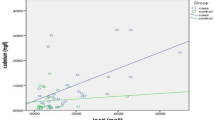Abstract
We conducted a case-control study to evaluate the contribution of some risk factors to the development of scleroderma. Fifty-seven patients with scleroderma (seven males and 50 females) were interviewed with a structured questionnaire at Saga Medical School Hospital from 1993 to 1995. Fifty-seven controls, who were individually sex and age matched with each case, were also interviewed with the same questionnaire during the same period. Eight individuals of parents or siblings of the scleroderma patients had Raynaud’s phenomenon, as compared to none of the controls (P<0.01). Four siblings of the cases had been affected by autoimmune connective tissue diseases, as compared to none of the controls (P<0.05). The percentage of the cases who had experience in the work exposed to hand-arm stress or vibration was larger than that of the controls (P<0.05). These findings may reflect familial or environmental factors operating in the development of scleroderma.
Similar content being viewed by others
References
Masi AT, Clinical-epidemiological perspective of systemic sclerosis (scleroderma), in:Systemic Sclerosis: Scleroderma, Jayson MIV, Black CM (Eds), pp. 7–31. Wiley, New York (1988).
Steen VD, Oddis CV, Conte CGet al., Incidence of systemic sclerosis in Allegheny County, Pennsylvania. A twenty-year study of hospital-diagnosed cases, 1963–1982,Arthritis Rheum 40, 441–445 (1997).
Tamaki T, Mori S, Takehara K, Epidemiological study of patients with systemic sclerosis in Tokyo,Arch Dermatol Res 283, 366–371 (1991).
Michet CJ Jr, McKenna CH, Elveback LRet al., Epidemiology of systemic lupus erythematosus and other connective tissue diseases in Rochester, Minnesota, 1950 through 1979,Mayo Clin Proc 60, 105–113 (1985).
Maricq HR, Weinrich MC, Keil JEet al., Prevalence of scleroderma spectrum disorders in the general population of South Carolina,Arthritis Rheum 32, 998–1006 (1989).
Silman AJ, Epidemiology of scleroderma,Ann Rheum Dis 50, 846–853 (1991).
Welsh KI, Black CM, Environmental and genetic factors in Scleroderma, in:Systemic Sclerosis: Scleroderma, Jayson MIV, Black CM (Eds), pp. 33–47. Wiley, New York (1988).
Silman AJ, Hochberg MC, in:Epidemiology of the Rheumatic Diseases, pp. 193–216. Oxford University Press, Oxford (1993).
Schlesselman JJ, in:Case-control Studies. Design, Conduct, Analysis, pp. 7–123. Oxford University Press, Oxford (1982).
Subcommittee for Scleroderma Criteria of the American Rheumatism Association Diagnostic and Therapeutic Criteria Committee, Preliminary criteria for the classification of systemic sclerosis (scleroderma),Arthritis Rheum 23, 581–590 (1980).
Breslow NE, Day NE, in:Statistical Methods in Cancer Research. Vol. 1. The Analysis of Case-control Studies, pp. 247–279. IARC, Lyon (1980).
SAS Institute Inc, SAS Technical Report P-217, SAS/STAT Software, The PHREG Procedure, Version 6, pp. 1–59. SAS Institute, Cary (1991).
Sheldon WB, Lurie DP, Maricq HRet al., Three siblings with scleroderma (systemic sclerosis) and two with Raynaud’s phenomenon from a single kindred,Arthritis Rheum 24, 668–676 (1981).
McGregor AR, Watson A, Yunis Eet al., Familial clustering of scleroderma spectrum disease,Am J Med 84, 1023–1032 (1988).
Bunker CB, Atherton D, Gray OPet al., Familial Raynaud’s phenomenon and localized scleroderma associated with essential telangiectasia and cytogenetic abnormalities,J Royal Soc Med 83, 531–532 (1990).
Maddison PJ, Stephens C, Briggs Det al., Connective tissue disease and autoantibodies in the kindreds of 63 patients with systemic sclerosis,Medicine 72, 103–112 (1993).
Flores RH, Stevens MB, Arnett FC, Familial occurrence of progressive systemic sclerosis and systemic lupus erythematosus,J Rheumatol 11, 321–323 (1984).
Rose T, Nothjunge J, Schlote W, Familial occurrence of dermatomyositis and progressive scleroderma after injection of a local anesthetic for dental treatment,Eur J Pediatr 143, 225–228 (1985).
Stephens CO, Briggs DC, Whyte Jet al., Familial scleroderma-evidence for environmental versus genetic trigger,Br J Rheumatol 33, 1131–1135 (1994).
Manolios N, Dunckley H, Chivers Tet al., Immunogenetic analysis of 5 families with multicast occurrence of scleroderma and/or related variants,J Rheumatol 22, 85–92 (1995).
Maeda M, Mori S, Occupational or extrinsic stimulation factors and initial signs of progressive systemic sclerosis,Int J Dermatol 31, 257–259 (1992).
Maeda M, Matsubara Ket al., Pitting scar in progressive systemic sclerosis,Dermatology 187, 104–108 (1993).
Pelmear PL, Roos JO, Maehle WM, Occupationally-induced scleroderma,J Occup Med 34, 20–25 (1992).
Sluis-Cremer GK, Hessel PA, Nizdo EHet al., Silica, silicosis, and progressive systemic sclerosis,Br J Ind Med 42, 838–843 (1985).
Rustin MHA, Bull HA, Ziegler Vet al., Silica-associated systemicc sclerosis is clinically, serologically and immunologically indistinguishable from idiopathic systemic sclerosis,Br J Dermatol 123, 725–734 (1990).
Sanchez-Roman J, Wichmann I, Salaberri Jet al., Multiple clinical and biological autoimmune manifestations in 50 workers after occupational exposure to silica,Ann Rheum Dis 52, 534–538 (1993).
Black CM, Welsh KI, Walker AEet al., Genetic susceptibility to scleroderma-like syndrome induced by vinyl chloride,Lancet i, 53–55 (1983).
Silman AJ, Jones S, What is the contribution of occupational environmental factors to the occurrence of scleroderma in men?Ann Rheum Dis 51, 1322–1324 (1992).
Giordano M, Valentini G, Lupoli S, Giordano A, Pregnancy and systemic sclerosis,Arthritis Rheum 33, 237–238 (1985).
Silman AJ, Black CM, Increased incidence of spontaneous abortion and infertility in women with scleroderma before disease onset: a controlled study,Ann Rheum Dis 47, 441–444 (1988).
McHugh NJ, Reilly PA, McHugh LA, Pregnancy outcome and antibodies in connective tissue disease,J Rheumatol 16, 42–46 (1989).
Steen VD, Conte C, Day Net al., Pregnancy in women with systemic sclerosis,Arthritis Rheum 32, 151–157 (1989).
Englert H, Brennan P, McNeil Det al., Reproductive function prior to disease onset in women with scleroderma,J Rheumatol 19, 1575–1579 (1992).
Research Committee on Epidemiology of Intractable Diseases, in:Tokutei Shikkan Iryo Jyukyusha Chosashiryo, p. 137. The Ministry of Health and Welfare of Japan, Tokyo (1990) (in Japanese).
Author information
Authors and Affiliations
About this article
Cite this article
Mori, M., Ohta, A., Suzuki, N. et al. A case-control study on risk factors for scleroderma. Japanese Journal of Rheumatology 8, 239–248 (1998). https://doi.org/10.1007/BF03041245
Received:
Accepted:
Issue Date:
DOI: https://doi.org/10.1007/BF03041245




